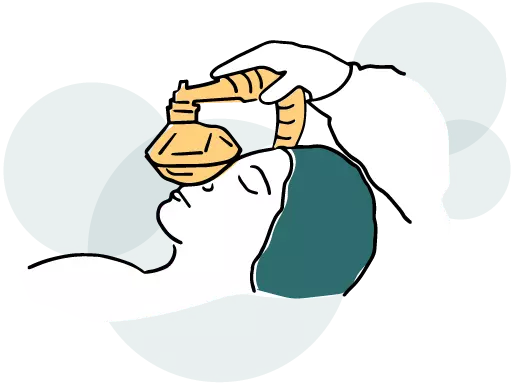

Management of MPS II: An MDT Approach (Anesthesia)


Progressive airway obstruction, caused by:1

Restricted movement of the temporomandibular joints, a stiff chest wall, and abdominal distension1

Tracheobronchomalacia1
Complications due to airway obstruction are a common cause of mortality in Hunter syndrome patients. Airway involvement is progressive by nature, first manifesting in the upper airways and spreading to the lower airways.1
General anesthesia can be difficult and risky due to the anatomic changes, including short neck, jaw immobility, and upper airway obstruction, seen in MPS II patients.2 Ideally, MPS II patients should undergo general anesthesia in centers staffed with anesthesiologists experienced in MPS disorders, and local or regional anesthesia should be considered where possible.2,3 The possibility of combining multiple minor surgeries into one general anesthesia session should be evaluated, however, it is important to remember that extending the operation time greatly increases the risk of respiratory complications.2,4
Before surgery
Prior to surgery the patient should be assessed by a multidisciplinary team that includes a cardiologist, otorhinolaryngologist, and anesthetist, and a full cardiac assessment should be conducted.2 In order to evaluate the individual anatomy of the airway, a flexible nasendoscopy and computed tomography scan, or a video recorded bronchoscopy using a fiberoptic bronchoscope can be carried out prior to surgery.2,4 Parents should be consulted about the possibility of an acute airway obstruction resulting in an urgent tracheotomy or cricothyrotomy during intubation and extubation.4
During surgery
Because the atlantoaxial joint is unstable in MPS II patients, careful positioning is required to avoid hyperextension of the neck.3 In some centers it is common practice for an otolaryngologist or pediatric pulmonologist to be available during the induction of anesthesia and intubation of the patient.4 Bronchoscopic intubation is often the most appropriate intubation technique, because of the tracheomalacia of the airway.2,4 In difficult patients or for brief procedures, a laryngeal mask may provide adequate airway control.4
After surgery
Early extubation can reduce the risk of post-obstruction pulmonary edema exacerbating upper airway obstruction.2 Using a helium-oxygen breathing mixture at the time of extubation may relieve the upper airway obstruction and improve outcomes because the reduced density of this air mixture decreases the work of breathing and increases linear flow rates.4 Recovery from anesthesia can be slow in MPS II patients.3
1. Martin R et al. Pediatrics. 2008;121(2):e377-e386. 2. Scarpa M et al. Orphanet J Rare Dis. 2011;6:72. 3. Neufeld EF, Muenzer J. In: Scriver CR et al (Eds). The Metabolic and Molecular Basis of Inherited Disease. New York, NY: McGraw-Hill; 2001:3421-3452. 4. Muenzer J et al. Pediatrics. 2009;124(6):e1228-e1239.
Hunter syndrome is a
progressive genetic disease
If you suspect Hunter syndrome, refer your patient to a metabolic geneticist for an accurate diagnosis.